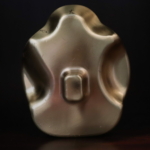Description
This sacred Tsatsa mold, forged from polished brass, holds the radiant form of Manjushri, the Bodhisattva of Wisdom. Standing 10 cm in height and 8 cm in width, with a weight of 0.65 kg, its finely etched details unveil his youthful grace, the flaming sword raised in his right hand, and the lotus-borne scripture in his left. Each meticulous line of this mold is an offering of artistry, providing a means to create Tsatsas that shine with the light of discernment.
Manjushri, the gentle prince of insight, emerges from the boundless compassion of the Buddhas to cut through the veils of ignorance. Known as the wielder of the sword of wisdom, he severs delusion with its fiery edge, while the Prajnaparamita text he holds reveals the emptiness of all phenomena. His golden form, adorned with the ornaments of awakening, inspires seekers across traditions to sharpen their minds and embrace the clarity of true understanding. Through his mantra, Om A Ra Pa Ca Na Dhih, he awakens the intellect of all who call upon him.
With this mold, the clay you shape becomes a vessel of Manjushri’s blessings, each Tsatsa a spark of wisdom to illuminate the path. Crafting his image purifies confusion, enhances insight, and plants the seeds of profound realization. Place these Tsatsas on your shrine, within a stupa, or in a sacred space, and their presence will sharpen awareness and dispel the fog of ignorance. Whether left plain or painted with devotion, they stand as silent guides, offering clarity and benefit to all who gaze upon them.
How to make Tsatsa
Here is a simple yet profound way to create Tsatsas, explained in five steps with the clarity of a lama’s guidance, for those who seek to walk this sacred path:
Prepare with Intention
Start with a clear mind, dedicating the act to the welfare of all beings. Gather fine, soft clay and a clean mold—perhaps of a Buddha or stupa. Dust the mold lightly with dry clay or ash to ease the release. This prepares the ground for the sacred work.
Shape with Care
Work the clay until smooth and pliable, then press it firmly into the mold. Fill every detail with steady hands, ensuring no gaps remain. This forms the holy image, a reflection of the awakened state.
Release with Patience
Once the clay sets slightly—not too wet or brittle—gently tap or ease the Tsatsa from the mold. Handle it with respect, allowing it to emerge naturally, as truth reveals itself in stillness.
Dry with Reverence
Set the Tsatsa in a shaded, peaceful place to dry—under soft sunlight or near a shrine. Let it harden at its own pace. Some blend sacred ashes or herbs into the clay beforehand, linking it to the blessings of the lineage. This is its time of settling.
Offer with Purpose
When dry, place the Tsatsa on an altar, in a stupa, or at a holy site. Offer a prayer to consecrate it, inviting the presence of enlightenment. It may remain plain or be painted with devotion. Each Tsatsa becomes an offering of merit and purification.
Through these five steps, the ordinary transforms into the extraordinary. Every Tsatsa crafted in this way radiates benefit, illuminating the path for all who encounter it.

























Reviews
There are no reviews yet.